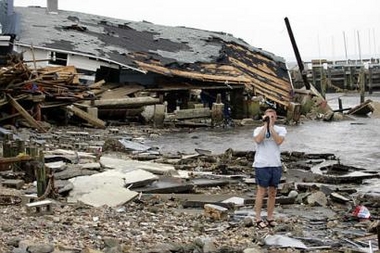|
Ophelia slows to a soaking crawl off US North Carolina
(AP)
Updated: 2005-09-16 11:04
Hurricane Ophelia, North Carolina's least welcome guest, refused again to leave Thursday, lashing the Outer Banks with rain and wind as coastal residents elsewhere returned home to damaged homes and businesses.
Ophelia just "beat us and beat us and beat us," one storm-weary resident said before the system was downgraded to a tropical storm Thursday night when its sustained winds dropped to 70 mph.
While the weakening storm's center was expected to stay just off shore, the northern side of Ophelia's eyewall, the ring of high wind surrounding the eye, could remain over the Outer Banks until midday Friday, the National Hurricane Center said.
Gov. Mike Easley said gauging the scope of the damage was difficult because of the storm's slow path, first affecting the state's southeastern coast on Tuesday and then crawling north and east Wednesday and Thursday to its position off the Outer Banks.
"It's almost like working three different storms," Easley said.
More than 48,000 homes and businesses remained without power Thursday evening in eastern North Carolina, utilities said. That was down from a peak of about 120,000 the previous night.
It appeared the mainland had dodged the severe flooding many had feared, but the wind and waves had taken a toll.
"We were not expecting this," said Laurie Garner, whose boyfriend's restaurant was severely damaged at Salter Path on Bogue Banks, southwest of Morehead City. "It just beat us and beat us and beat us."

Jack Borinski, of Richmond, Va., videotapes the damage caused by Hurricane Ophelia in Salter Path, North Carolina, the USA, Thursday, Sept. 15, 2005.[AP] |
Salter Path Fire Capt. Joey Frost estimated that as many as 25 people had to be rescued. In neighboring Emerald Isle, six houses were destroyed and more than 120 had major damage, Fire Capt. Bill Walker said.
Ophelia, an erratic storm that has looped and meandered north since forming off the Florida coast last week, stalled early Thursday afternoon, then resumed a slow eastward drift toward the open ocean, the hurricane center said.
A hurricane warning for the North Carolina coast was reduced to a tropical storm warning, extending from Cape Lookout northward to Cape Charles Light, Va., including the mouth of Chesapeake Bay, the hurricane center said.
The storm was blamed for one traffic death. Earlier, a surfer disappeared in rough water off the coast of South Carolina.
On the Outer Banks, Dare County officials said Hatteras Island reported gusts to 95 mph.
Other than power outages, Hatteras Island was in pretty good shape, said county spokeswoman Sharon Sullivan.
Farther north on the Outer Banks, most businesses remained open in Nags Head and Manteo and a few people braved intermittent rain squalls to shop or check out the surf.
David Goddard, 58, of Ashburn, Va., said he was a bit disappointed in Ophelia.
"I'm a weather junkie," he said. "I thought it was gonna be worse than this."
Ocean water was not expected to wash over the islands, although coastal storm surge flooding of 4 feet to 6 feet above normal tide was expected, along with large and battering waves.
At 8 p.m. EDT, Ophelia was centered about 45 miles south-southeast of Cape Hatteras. It was drifting east at about 5 mph and was expected to pick up some speed Friday, the hurricane center said. With top sustained winds of 70 mph, it was 4 mph below hurricane strength.
A tropical storm watch was issued for southeastern Massachusetts, including Cape Cod, Nantucket and Martha's Vineyard.
South of the Outer Banks, Ophelia had cleared out and residents were able to begin surveying the damage.
At Salter Path on Bogue Banks, Ophelia had ripped off the back of Vernon Guthrie's Crab Shack restaurant and chairs and tables were floating in water, according to Garner, Guthrie's girlfriend. It was the sixth time in 30 years a storm has taken off that side of the restaurant, which looks out on Bogue Sound, Guthrie said.
"Yeah, we're going to rebuild. One more time ain't going to hurt," he said.
Ophelia is the 15th named storm and seventh named hurricane of this year's busy Atlantic season, which ends Nov. 30.
|